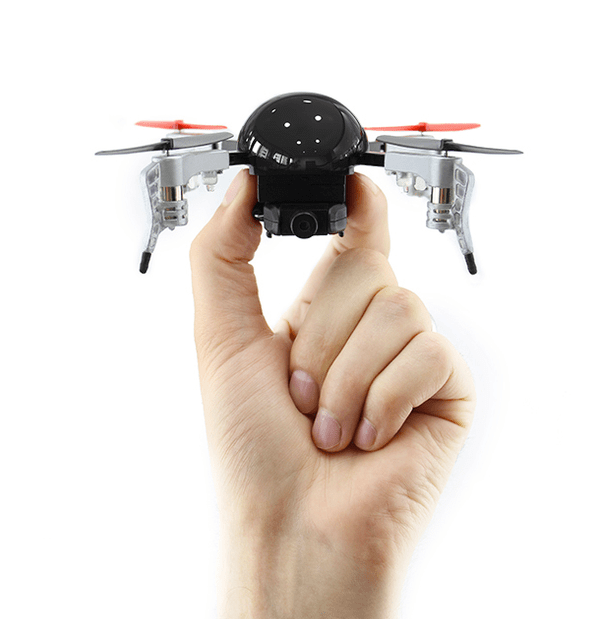
ExtremeFliers are back crowdfunding the third generation of their micro drone. This time the teeny quadcopter will be able to live stream footage straight to Meerkat. Or it will if they raise the $75,000+ they’re looking for via Indiegogo.
Yep, called it…
“I’ve not seen any other drones that are integrated with Meerkat at the moment. We are the first,” says co-founder Vernon Kerswell.
Why Meerkat not Periscope? Because the former has an open API, and the latter is owned by Twitter doesn’t yet.
ExtremeFliers Micro Drone 2.0, which sold 60,000 units, had a camera but Drone 3.0 upgrades the quality to 720p HD — all the better for your social media live broadcasting needs. The drone is priced at $125 for the earliest crowdfunder backers.
Other upgrades focus on making it easier to pilot. Plus there’s a dual control mechanism, so the drone can be controlled from up to 50-ft via a smartphone app, or (for greater range, of ~300-ft) via the main controller.
There will also be a new dronie footage stabilizing accessory — in the form of what Kerswell says is the world’s smallest gimbal (costing $50) to ensure steadier video.
Micro Drone 3.0 is designed to be modular, with additional parts (such as the gimbal) snapping on via magnets. The quadcopter will fly for around 8 minutes per battery charge. Again, the battery is snap on so it can be swapped out more quickly.
“We build the main board as well as the structure of the drone. We started off with the structure by making it a modular drone which is really easy to pull apart and put back together again so that overcomes all the issues of breakages — you can just swap parts in and out. For the main board, because we’ve been making this since 2011, we’ve been able to iterate pretty rapidly on the actual control board and the system for flying it,” he tells TechCrunch.
“For 2.0 we had a six axis gyro which made it fly stable and be able to throw it in the air. With 3.0 we’ve upgraded the sensors so now you can, using an accelerometer, a six-axis gyro and an electronic compass you can fly much more stable. It takes away a lot of the hands on difficulties of piloting it, and gives it a thing called ‘smart orientation’, so you don’t have to know what the front of the drone is. No matter if you go forward or backwards, the drone always goes in that direction.”
Kerswell reckons consumer drones are still a long way off autonomous flight, so the focus is about making flight “more automatic”, although a human eye is still needed to guide the quadcopter (albeit last year another U.K. company, Zano, launched a crowdfunder for a selfie drone designed to fly itself — so startups are certainly attempting to build self-flying drones at this point).
“We’re a long way off true autonomous flying,” says Kerswell. “We’ve been working really hard on that using biometric pressure sensors and sonar and IR sensors. That’s technology that can enable better autonomy, but there’s still a lot of technical difficulties — for example with IR sensors you only get 5-ft of range. With sonar… it doesn’t overcome the drift. And if there are obstacles it will just sort of jump up. And with GPS you can only use it outdoors whereas you need it for indoors.
“The sensors we are using — the compass, the accelerometer, the six-axis gyro — that makes it more automatic so it’s a lot easier to fly than previous versions.”
Kerswell’s view is that computer vision tech is the way to achieve “good obstacle avoidance” on small consumer drones in future, rather than using IR sensors. “I think obstacle avoidance and autonomy will happen eventually but it will be more a sort of computer vision solution where it can use video from the camera to be able to detect objects and then use that to avoid — knowing what obstacles are and being able to take action to correct itself,” he adds.
ExtremeFliers is self funded, with the profits from Micro Drone 2.0 ploughed back into the business to develop the third gen — and crowdfunding remaining its preferred route to market, as it focuses on building an ecosystem of developers and users. Kerswell says it hopes to be able to double sales with the new Micro Drone 3.0. The aim is to ship to backers by November.
“We’re ready to go into production with the 3.0. We’ve got a working prototype… We wanted to do crowdfunding because the drone is modular so the crowdfunding communities are pretty hands on with the development — and that’ll open up opportunities for third party developers to get involved with development, like modules,” he says.
“Already, at some of the events we’ve been to, we’ve found developers who want to make things like laser pens, Gatling guns, fish eye lenses, really sophisticated modules that just snap onto the drone. Also building a community that helps make an ecosystem — I think that’s one of the fastest ways to get this into the hands of people. And it kind of validates it. If people like this then it’s a product which has been developed by people based on feedback.”
Комментариев нет:
Отправить комментарий